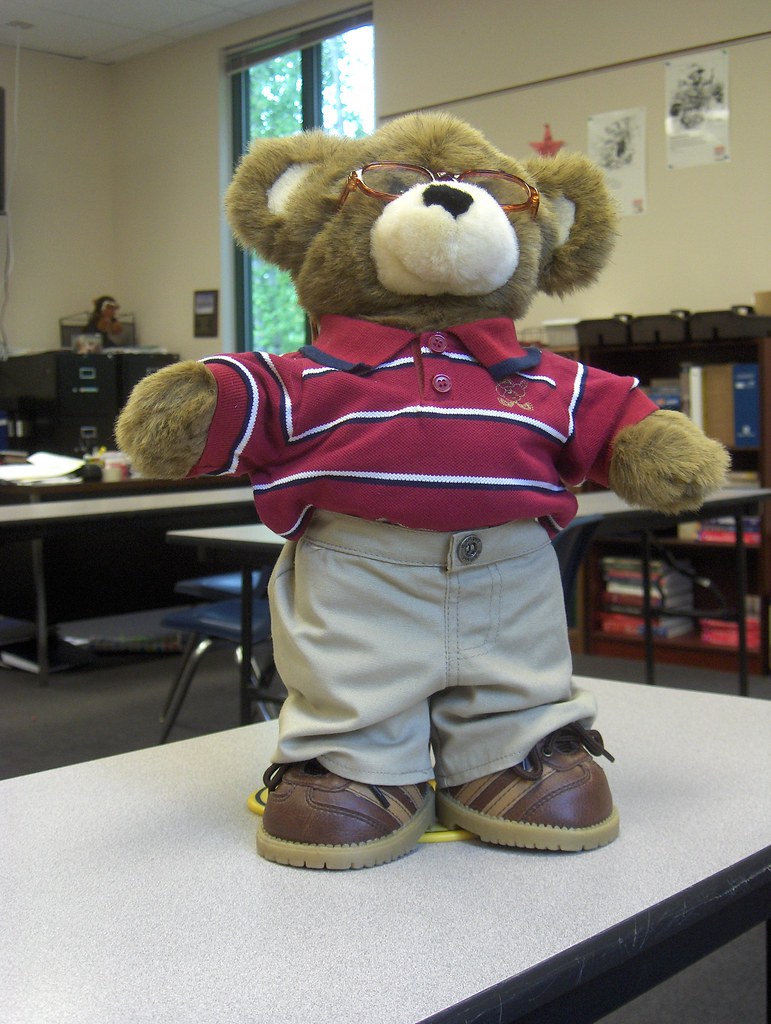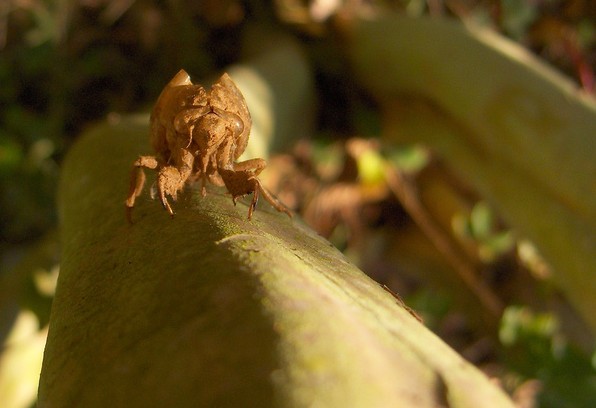
If you know me, then you know they got it right.
If you go to Flickr and look at the picture more closely, you will see that in the background just above the Bear's right shoulder is a stuffed monkey. Clearly, I have a long history of unusual gifts (and look here). The monkey came to me about five years ago.
Here is the story of the monkey: I have always struggled in creating tests for my AP (advanced placement) classes. Genuine AP multiple-choice questions are well-written, extremely challenging, and the College Board has only released a limited number of their questions. I use as many of their questions as I can on my tests, but there are never nearly enough for a complete test. Strangely, most of the other standard sources for multiple-choice questions (like the textbook's test bank) are actually either poorly written or contain only four choices. The College Board uses five choice multiple-choice questions. On the rare occasions when I have been able to use one of the test bank questions, I have had to add a fifth answer. The structure of the question often makes it challenging to write an appropriate fifth answer.
One late, test-writing night about six years ago I began adding "creative" fifth answers to the questions. Some of them were lame, cultural references (usually relating to Britney Spears), but the bulk of them developed into a story concerning the attempts of a species of super-intelligent subterranean monkeys to take over the world. They were such great hits, I began adding punch lines to most of my tests. The students end up much more relaxed, and they tend to read all of the answers much more clearly. So my students got me a monkey at the end of the year. Since then my AP classes have passed the monkey around for luck before every test (there is a pun there about monkeying around--but I shall spare you). Here are some samples in a neat little quiz (answer in the comments if you wish, but no cheating):
1. The Whigs in 1840
a. Feared splitting their party and hence had no platform
b. Nominated Winfield Scott for president
c. Campaigned for a program similar to Clay’s American System
d. Tried to play down their candidate's war record
e. Advocated the violent overthrow of the US government and the institution of government by monkey
2. As part of the “Great Biological Exchange,” Europeans brought to the New World
A. A horde of subterranean monkeys hidden in the hold of a supply vessel
B. Tomatoes
C. Peanuts
D. Olives
E. Tobacco
3. The cotton gin was invented
a. By James Watt
b. By John Kay
c. In the 1790’s
d. In the 1830’s
e. By 1,000 monkeys typing away at 1,000 typewriters for a thousand years
4. In the Webster-Hayne Debate, Daniel Webster argued that
a. Each section of the country had to stand up and fight, if necessary, for its rights
b. States had the right to nullify national laws
c. The Union was made up of sovereign states
d. Final jurisdiction on all questions of constitutionality rested in the nation’s Supreme Court
e. Robert Hayne was a “big-poopie head that is not allowed to pick his nose without the permission of the Federal government.”
5. The Fourteenth Amendment to the Constitution
A. outlawed slavery.
B. guaranteed citizens the equal protection of the laws.
C. specifically gave the former slaves the right to vote.
D. ended Reconstruction in the South.
E. gave all Monkeys the right to “a free and unimpeded flow of bananas”
Not my best questions, but you get the idea.
I watched the movie The Day After today. Do any of you remember this 1983 made for TV movie about the consequences of a full-scale nuclear war on a community in Kansas? I think I remember seeing it in 8th or 9th grade and being scared out of my mind. The reason I ask is that AP exams are this week, and we usually take it easy after the exam so I am thinking about a unit on the Cold War through film. Here is my potential list: Dr. Strangelove, War Games, and Red Dawn. None of them are brilliant (with the possible exception of Dr. Strangelove--but I love Peter Sellers) but The Day After (1983), War Games (1983), and Red Dawn (1984) were made during a two-year stretch near the beginning of Reagan's presidency. Why could that be? I probably only have time for three films. Any suggestions?
Peace
..._

2 comments:
Ah! Early Reagan-era Apocolypsis (or ERA for short). Hollywood was so aghast that we had elected such a tough-talker, they figured we were destined for nuclear doom, and it showed in their work.
Escape From New York might fit the profile, but it's not for kids (I'd get mad if they showed that in my child's class). Also Omega Man, as an earlier example. Soylent Green captures the dystopian feel of the late Cold War, as does the original Planet of the Apes (what is it with Charleton Heston and the end of the world?).
Anyway, for a great list of post-apocalyptic movies (and links to books), check out http://www.pamedia.com/movies/.
Great link--thanks. Maybe I can just show the Statue of Liberty scene from Planet of the Apes--I wouldn't want to put them through the entire thing. We could contrast it with the "Statue of Liberty, Eh" scene from Strange Brew!
Post a Comment